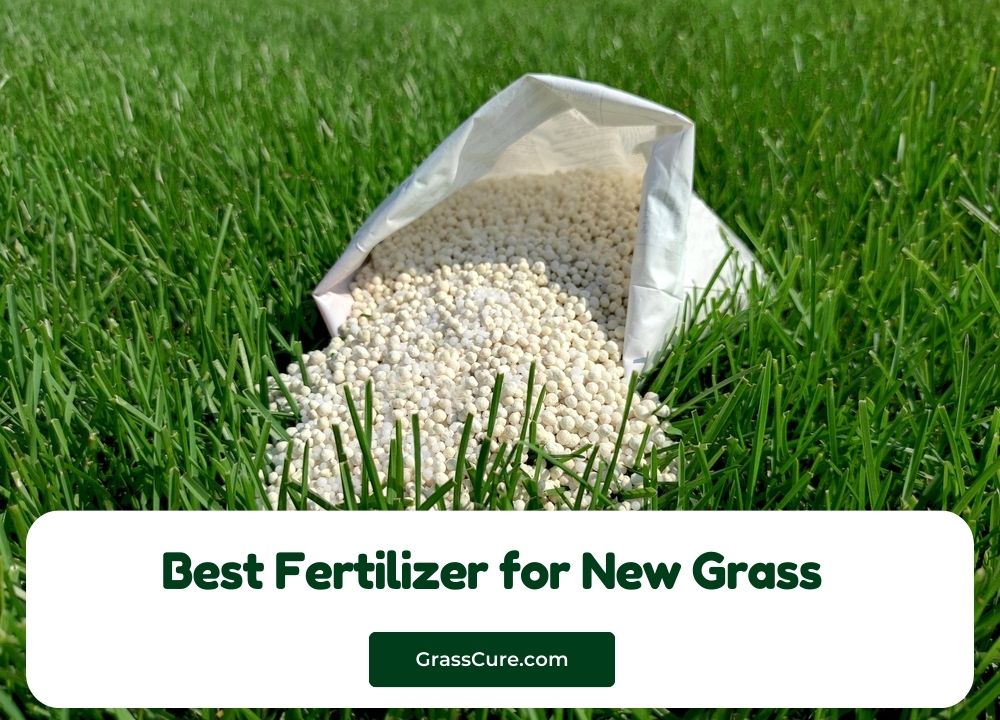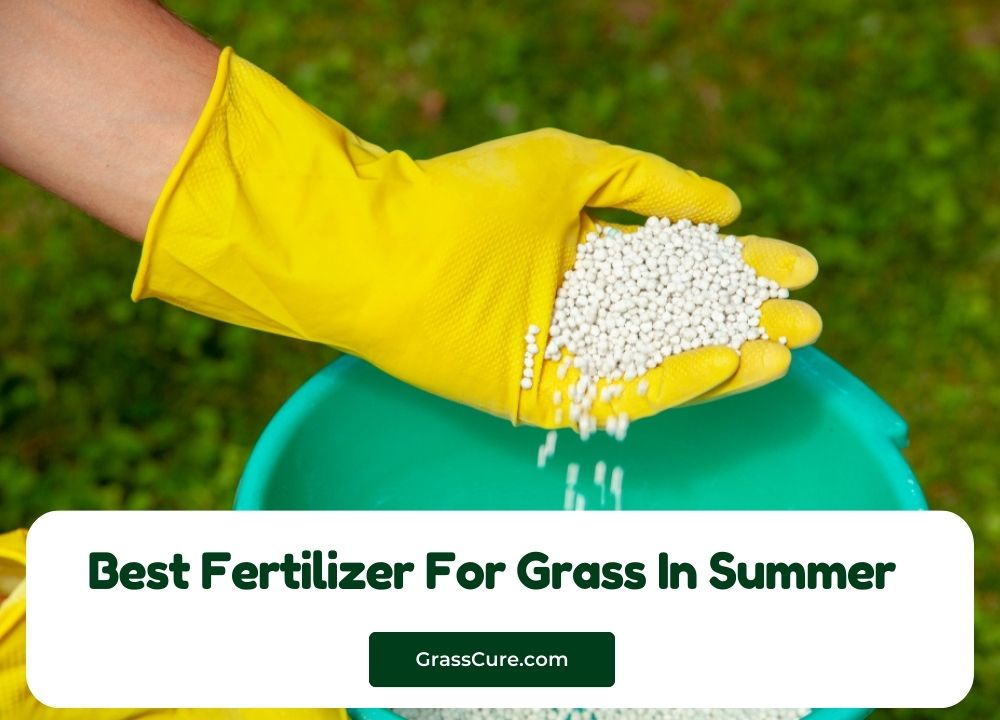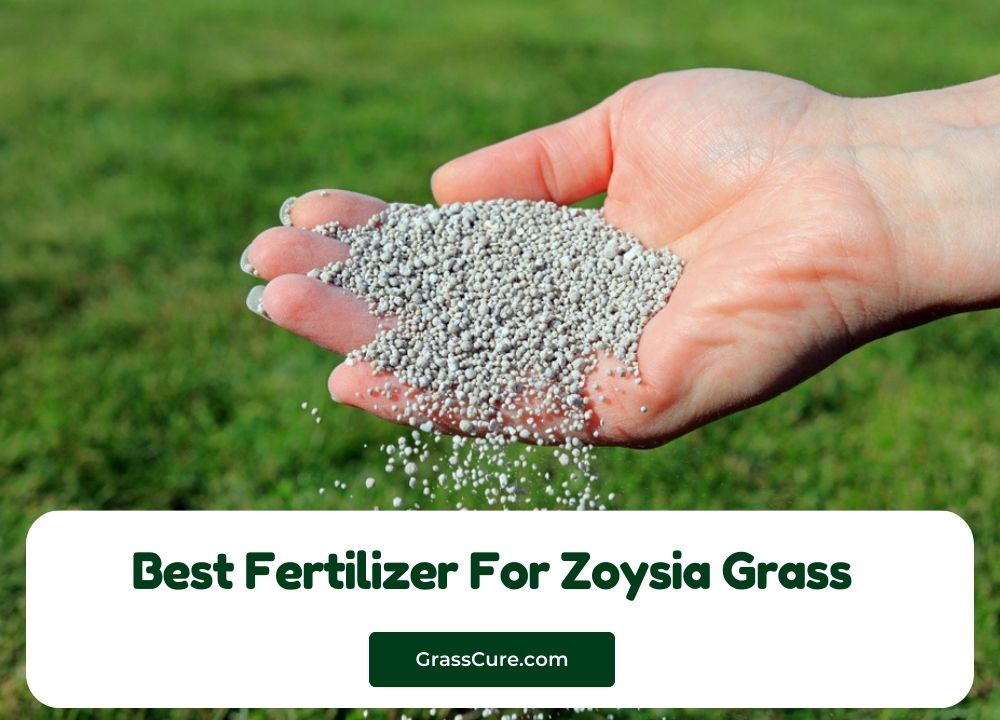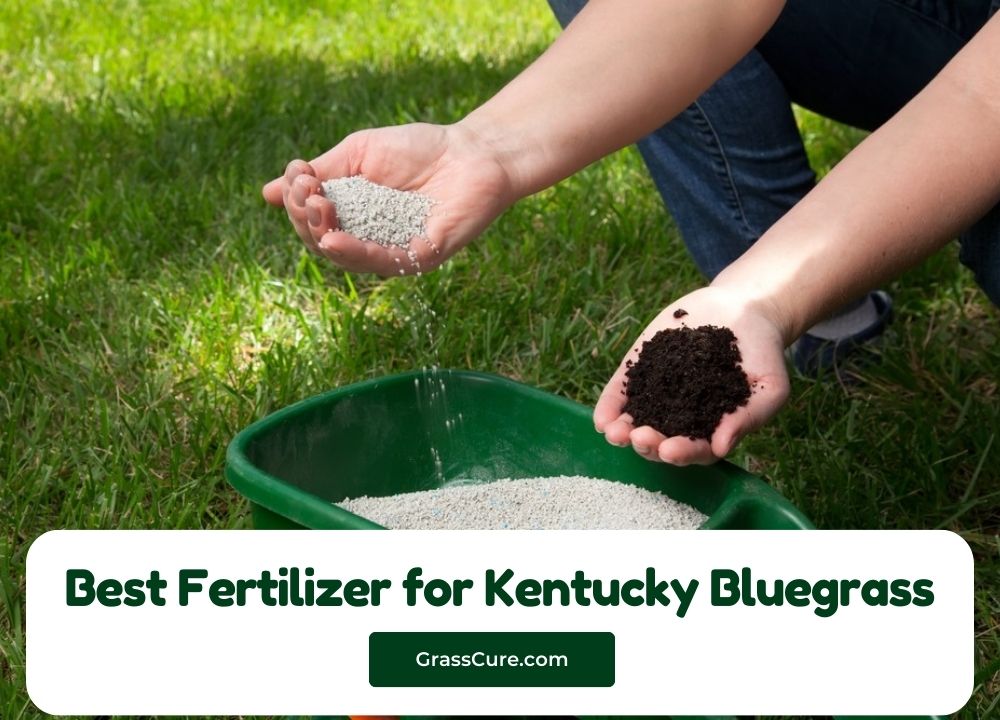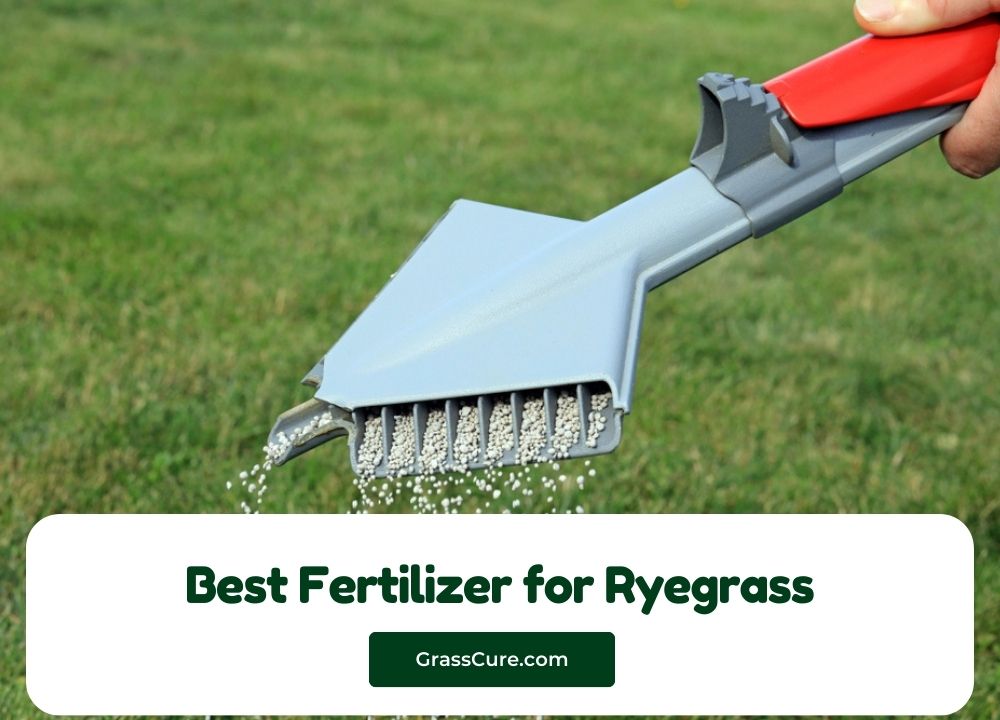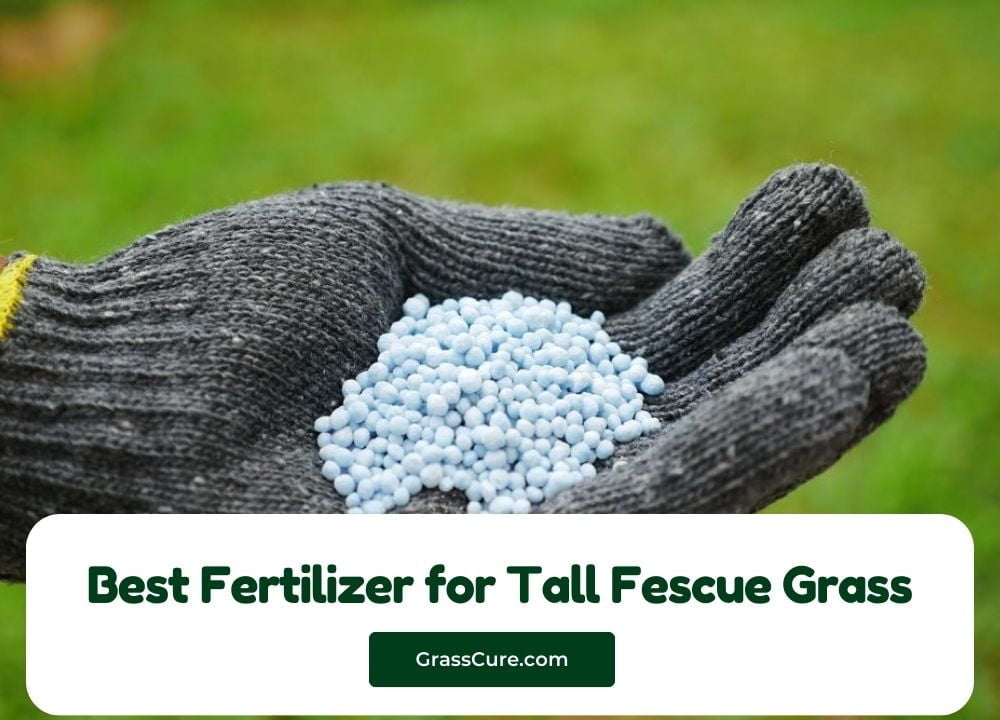Establishing a lush, green lawn begins with choosing the right fertilizer for new grass. Fertilizing is crucial during the initial stages of growth, as it provides essential nutrients that promote healthy germination and root development. With a variety of fertilizers available—ranging from synthetic to organic options—understanding their differences and benefits can be overwhelming for homeowners. This article aims to guide you through the best fertilizer for new grass, ensuring you make an informed decision to help your lawn thrive. Whether you’re starting from seed or laying sod, the right fertilizer can set the foundation for a vibrant and healthy lawn.
Top Fertilizer for New Grass
1. Scotts Turf Starter Food for New Grass
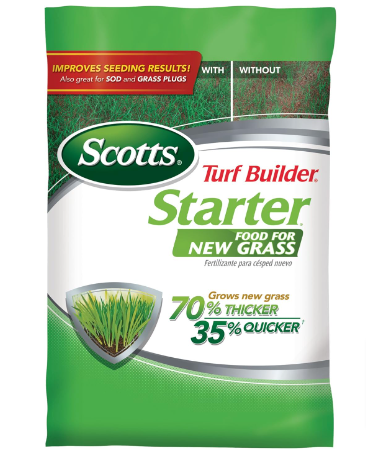
Scotts Turf Builder Starter Fertilizer is specifically designed to nourish new grass seed and sod. This fertilizer promotes strong root development and helps establish a robust lawn, ensuring your new grass gets off to a healthy start.
Nutrient Composition:
- N-P-K Ratio: 24-25-4
- Nitrogen (N): Promotes lush, green growth.
- Phosphorus (P): Essential for strong root development.
- Potassium (K): Supports overall health and disease resistance.
Pros:
- Fast-acting formula encourages rapid germination and growth.
- High phosphorus content is ideal for new grass.
- Covers up to 5,000 square feet, making it suitable for larger areas.
- Easy to apply using a broadcast spreader or by hand.
Cons:
- Higher nitrogen levels may not be suitable for established lawns.
- Some users may find it too strong if over-applied.
Best Use Cases:
- Ideal for use when planting new grass seed or laying sod.
- Recommended for early spring or early fall applications to align with grass growth cycles.
Scotts Turf Builder Starter Fertilizer is an excellent choice for homeowners looking to establish a healthy, vibrant lawn from the ground up.
2. Scotts Turf Builder Food for New Grass Plus Weed Preventer

Scotts Turf Builder Weed & Feed 5 is a dual-action formula that combines weed control with lawn fertilization. Designed to target common weeds like dandelions and clover, this product not only helps eliminate unwanted plants but also promotes a lush, green lawn.
Nutrient Composition:
- N-P-K Ratio: 28-0-3
- Nitrogen (N): Provides essential nutrients for robust grass growth.
- Phosphorus (P): Not included in this formula, focusing solely on weed control and grass health.
- Potassium (K): Enhances drought resistance and overall lawn vigor.
Pros:
- Effectively controls broadleaf weeds while feeding the grass.
- Covers up to 12,000 square feet, making it ideal for large lawns.
- Can be applied during the growing season, typically in spring or early fall.
Cons:
- Not suitable for use on newly seeded or sodded lawns.
- Requires moisture (rain or watering) after application for best results.
Best Use Cases:
- Ideal for established lawns needing weed control while promoting healthy growth.
- Best applied during active growing seasons to maximize effectiveness against weeds.
Scotts Turf Builder Weed & Feed 5 is a convenient solution for homeowners looking to maintain a healthy lawn while keeping it free of common weeds, ensuring a beautiful, green space.
3. Scotts Turf Builder Triple Action
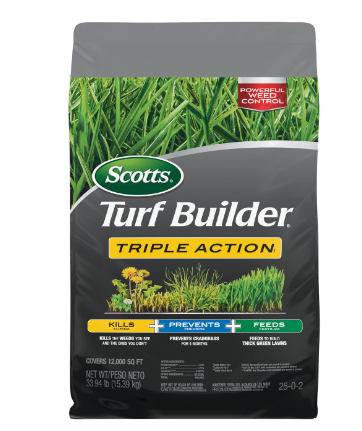
Scotts Turf Builder Triple Action 1 is a versatile lawn care product that combines weed control, weed prevention, and fertilization in one formula. Designed for homeowners seeking a comprehensive solution, this product effectively tackles existing weeds while preventing new ones from emerging.
N-P-K Ratio:
- N-P-K Ratio: 28-0-3
- Nitrogen (N): Promotes vigorous grass growth and a lush, green lawn.
- Phosphorus (P): Not included in this formulation, as the focus is on weed control and maintenance.
- Potassium (K): Supports overall lawn health and enhances drought resistance.
Pros:
- Provides three benefits in one application: weed control, prevention, and fertilization.
- Covers up to 12,000 square feet, making it suitable for large lawns.
- Effective against a wide range of weeds, including dandelions and clover.
- Can be applied in spring or fall for optimal results.
Cons:
- Not suitable for newly seeded lawns; should only be applied to established grass.
- Requires moisture (rain or irrigation) to activate the weed control properties.
Best Use Cases:
- Ideal for maintaining established lawns that need both weed control and fertilization.
- Best applied during active growing seasons to maximize effectiveness.
Scotts Turf Builder Triple Action 1 is an excellent choice for homeowners looking for an all-in-one solution to maintain a healthy, weed-free lawn while ensuring strong grass growth.
4. Milorganite Slow-Release Nitrogen Fertilizer
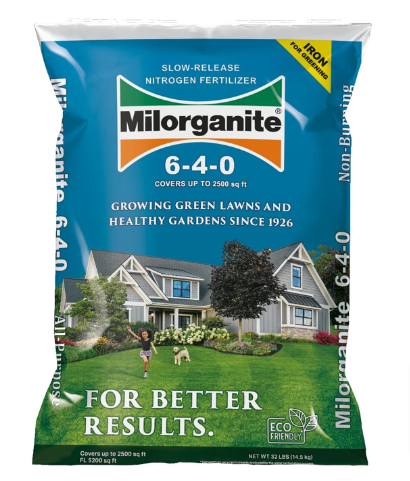
Milorganite All-Purpose Fertilizer is an eco-friendly option made from recycled organic matter. This slow-release formula is designed to provide a steady supply of nutrients over time, making it ideal for lawns, flowers, and gardens.
N-P-K Ratio:
- N-P-K Ratio: 6-4-0
- Nitrogen (N): Encourages healthy growth and vibrant green color.
- Phosphorus (P): Supports root development and flowering.
- Potassium (K): Not present in this formula, focusing primarily on nitrogen and phosphorus benefits.
Pros:
- Eco-friendly formulation made from recycled materials, promoting sustainability.
- Slow-release nitrogen provides long-lasting nourishment for plants.
- Versatile for use on various types of plants, including lawns, flowers, and vegetable gardens.
- Low risk of burning plants, making it safe for all types of garden environments.
Cons:
- Lower nitrogen content compared to some synthetic fertilizers, which may result in slower initial growth.
- The earthy smell may be off-putting to some users, especially when first applied.
Best Use Cases:
- Ideal for established lawns that need a gentle, sustained nutrient boost.
- Excellent for flower beds and vegetable gardens where long-term feeding is beneficial.
Milorganite All-Purpose Eco-Friendly Slow-Release Fertilizer is a great choice for environmentally conscious gardeners looking for a reliable and safe way to nourish their plants while promoting sustainable practices.
5. Lawn Food Natural Liquid Fertilizer by Simple Lawn Solutions
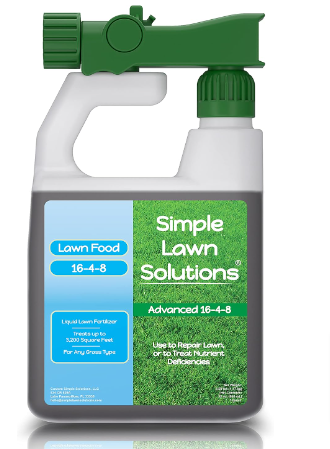
Advanced 16-4-8 Balanced NPK is a high-quality liquid fertilizer designed to meet the nutritional needs of all grass types during the spring and summer seasons. This concentrated spray formula is easy to apply, providing a quick nutrient boost to promote healthy growth and vibrant color.
N-P-K Ratio:
- N-P-K Ratio: 16-4-8
- Nitrogen (N): Supports vigorous growth and dark green color.
- Phosphorus (P): Aids in root development and improves flowering.
- Potassium (K): Enhances drought resistance and overall plant health.
Pros:
- Balanced nutrient composition suitable for all grass types.
- Fast-acting liquid formula allows for rapid absorption and visible results.
- Easy application using a hose-end sprayer or a garden sprayer.
- Ideal for use during the growing season to promote lush, green lawns.
Cons:
- Requires frequent applications, typically every 4-6 weeks, for optimal results.
- Liquid fertilizers may wash away faster than granular options if there’s heavy rainfall.
Best Use Cases:
- Perfect for homeowners looking to boost their lawn’s health during the growing season.
- Ideal for use in both established lawns and newly seeded areas, as it promotes strong growth.
Advanced 16-4-8 Balanced NPK Lawn Food is an excellent choice for those seeking an efficient and effective way to nourish their grass, ensuring a lush and vibrant lawn throughout the spring and summer months.
6. Lesco Professional, 50 LB, 12,000 SQFT Coverage, 18-24-12
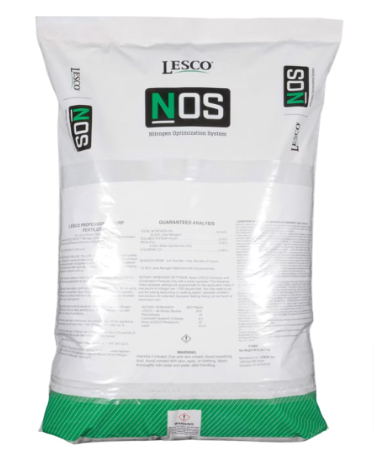
Lesco 18-24-12 Starter Fertilizer with Nitrogen Optimizing System (NOS) is specially formulated to provide essential nutrients for new grass seedlings and sod. This premium fertilizer enhances nitrogen use efficiency, ensuring that grass receives the nutrients it needs for healthy establishment and growth.
N-P-K Ratio:
- N-P-K Ratio: 18-24-12
- Nitrogen (N): Supports robust growth and green color.
- Phosphorus (P): Promotes strong root development, crucial for new grass.
- Potassium (K): Enhances overall health and drought resistance.
Pros:
- High phosphorus content is ideal for supporting new grass and root development.
- The Nitrogen Optimizing System maximizes nitrogen utilization, leading to extended greening and reduced waste.
- Covers up to 12,000 square feet, making it suitable for larger areas.
- Granular form allows for easy application with a spreader.
Cons:
- Higher nitrogen levels may not be necessary for established lawns.
- Requires watering after application for optimal nutrient absorption.
Best Use Cases:
- Ideal for use when planting new grass seed or laying sod.
- Recommended for spring and fall applications to align with grass growth cycles.
Lesco 18-24-12 Starter Fertilizer NOS is an excellent choice for homeowners and landscapers looking to establish a healthy, vibrant lawn quickly, providing the necessary nutrients for successful grass development.
7. The Andersons Premium New Lawn Starter 20-27-5 Fertilizer – Covers up to 5,000 sq ft (18 lb)
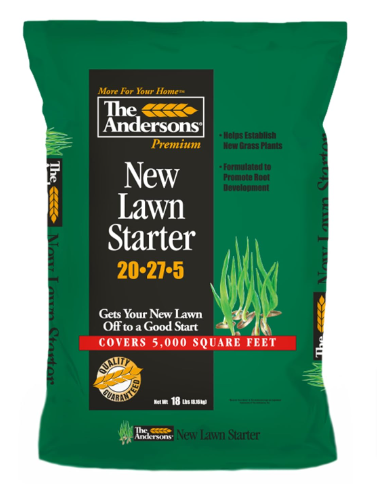
The Andersons Premium New Lawn Starter Fertilizer is designed specifically for new grass seed and sod. This high-quality formula provides essential nutrients to support early growth and establishment, helping homeowners achieve a lush, green lawn quickly.
N-P-K Ratio:
- N-P-K Ratio: 20-27-5
- Nitrogen (N): Promotes vigorous leaf growth and vibrant color.
- Phosphorus (P): Supports root development and enhances seedling establishment.
- Potassium (K): Strengthens overall plant health and improves drought resistance.
Pros:
- High phosphorus content (27) is ideal for promoting strong root growth in new lawns.
- Covers up to 5,000 square feet, making it suitable for smaller to medium-sized areas.
- Granular form allows for easy and uniform application with a spreader.
- Fast-acting nutrients lead to quicker results compared to standard fertilizers.
Cons:
- Higher nitrogen levels may not be needed for established lawns.
- Requires watering after application to activate nutrients and prevent burning.
Best Use Cases:
- Perfect for use when seeding new lawns or laying sod.
- Recommended for application in spring or early fall to align with grass growth periods.
The Andersons Premium New Lawn Starter Fertilizer is an excellent choice for those looking to establish a new lawn, providing the necessary nutrients for strong growth and a healthy, vibrant appearance.
Buying Guide for Lawn Fertilizers
When selecting the best fertilizer for your lawn, consider the following factors to ensure you choose the right product for your specific needs:
Determine Your Lawn Type
- Identify the type of grass in your lawn (e.g., cool-season vs. warm-season grasses) to choose a fertilizer that meets its specific nutritional requirements.
Understand the N-P-K Ratio
- N-P-K Ratio indicates the ratio of nitrogen (N), phosphorus (P), and potassium (K) in the fertilizer.
- Nitrogen (N): Promotes growth and lush green color.
- Phosphorus (P): Supports root development and overall health.
- Potassium (K): Enhances drought resistance and disease tolerance.
- Choose a fertilizer with a suitable N-P-K ratio based on your lawn’s growth stage (e.g., starter fertilizers for new grass often have higher phosphorus).
Choose Between Granular and Liquid Fertilizers
- Granular Fertilizers:
- Easy to apply with a spreader.
- Provide slow, steady nutrient release.
- Ideal for long-term feeding.
- Liquid Fertilizers:
- Fast-acting and quickly absorbed by grass.
- Often require more frequent applications.
- Great for quick fixes and boosting growth during the growing season.
Consider Organic vs. Synthetic Options
- Organic Fertilizers:
- Made from natural materials (e.g., compost, manure).
- Typically slower to release nutrients but improve soil health over time.
- Lower risk of burning plants.
- Synthetic Fertilizers:
- Chemically formulated for quick results.
- Often contain higher nutrient concentrations.
- May require careful application to avoid over-fertilization.
Evaluate the Coverage Area
- Check how much area the fertilizer covers (e.g., square feet). Choose a product that matches the size of your lawn to avoid wastage.
Application Timing
- Consider the best time to fertilize your lawn:
- Spring & Summer: Generally, high nitrogen fertilizers to promote growth.
- Fall: Fertilizers with higher potassium for winter hardiness.
- Some fertilizers are specifically designed for use at particular times of the year.
Check for Additional Benefits
- Some fertilizers come with added benefits, such as weed control or soil conditioning properties. If you have specific lawn care needs, look for products that offer these features.
Read Reviews and Recommendations
- Look for customer reviews and expert recommendations to gauge the effectiveness of the fertilizer. This can help you avoid products that may not deliver the expected results.
Consider Environmental Impact
- If you’re environmentally conscious, opt for eco-friendly fertilizers that minimize harm to the environment and promote sustainable gardening practices.
Follow Application Instructions
- Always follow the manufacturer’s instructions for application rates and methods to avoid over-fertilizing, which can harm your lawn.
Conclusion
Choosing the right fertilizer for your lawn is crucial for establishing and maintaining a healthy, vibrant green space. By understanding your specific grass type, the significance of the N-P-K ratio, and the differences between granular and liquid fertilizers, you can make informed decisions that promote optimal growth. Whether you opt for organic or synthetic options, the key is to match the fertilizer to your lawn’s needs, considering factors such as coverage area, application timing, and environmental impact. With careful selection and proper application, the right fertilizer can lead to a lush, thriving lawn that enhances the beauty of your outdoor space. Investing in quality fertilizer not only supports your lawn’s health but also contributes to a sustainable gardening practice, ensuring your green oasis flourishes for years to come.
Frequently Asked Questions (FAQ)
1. What is the best type of fertilizer for new grass?
The best fertilizer for new grass typically has a high phosphorus content, as this nutrient supports strong root development. Look for starter fertilizers with an N-P-K ratio like 20-27-5 or 18-24-12.
2. How often should I fertilize my lawn?
Fertilization frequency depends on the type of fertilizer used. Generally, granular fertilizers can be applied every 6-8 weeks, while liquid fertilizers may need to be applied more frequently, about every 4-6 weeks during the growing season.
3. Can I apply fertilizer to newly seeded grass?
Yes, but it’s essential to choose a fertilizer designed for new grass, such as a starter fertilizer, and follow the application guidelines. Avoid using high-nitrogen fertilizers until the grass is established, as this can lead to excessive leaf growth at the expense of root development.
4. What time of year is best for fertilizing my lawn?
Spring and fall are the best times for fertilizing most lawns. Spring is ideal for promoting growth, while fall fertilization helps prepare grass for winter. Always check the specific needs of your grass type, as cool-season and warm-season grasses have different fertilization schedules.
5. How do I know if my lawn needs fertilizer?
Signs that your lawn may need fertilization include yellowing grass, slow growth, and sparse areas. Conducting a soil test can also provide insight into nutrient deficiencies.
6. Is it safe to use fertilizer around pets and children?
While many fertilizers are safe when used correctly, it’s advisable to keep pets and children off treated areas until the fertilizer has been watered in and dried. Always read the product label for specific safety recommendations.
7. How should I apply fertilizer to my lawn?
For granular fertilizers, use a broadcast spreader to ensure even distribution. Liquid fertilizers can be applied using a hose-end sprayer or garden sprayer. Follow the manufacturer’s instructions for best results.
8. What happens if I over-fertilize my lawn?
Over-fertilization can lead to nutrient burn, which can damage or kill grass. Symptoms include brown patches, wilted leaves, and excessive growth followed by die-off. If over-fertilization occurs, water the lawn thoroughly to help dilute the fertilizer.
9. Can I use leftover fertilizer the next season?
Yes, you can typically store leftover fertilizer for future use. However, make sure it’s stored in a cool, dry place and in its original packaging. Check the expiration date and the condition of the fertilizer before using it again.
10. What are the benefits of using organic fertilizers?
Organic fertilizers improve soil health, enhance microbial activity, and provide a slow, steady release of nutrients. They have a lower risk of burning plants and promote sustainable gardening practices.
References
- Scotts Miracle-Gro Company. (n.d.). Lawn Care and Fertilization Tips. Retrieved from scotts.com
- The Andersons, Inc. (n.d.). Fertilizer Application Guides. Retrieved from andersonsplantnutrient.com
- Milorganite. (n.d.). How to Fertilize Your Lawn. Retrieved from milorganite.com
- Simple Lawn Solutions. (n.d.). Lawn Fertilizer Guide. Retrieved from simplelawnsolutions.com
- Lesco Fertilizers. (n.d.). Understanding Fertilizer Labels and Their NPK Ratios. Retrieved from lesco.com
- University of Florida Institute of Food and Agricultural Sciences (UF/IFAS). (2016). Fertilization of Home Lawns. Retrieved from edis.ifas.ufl.edu
- Penn State Extension. (2020). Lawn Fertilization: Best Management Practices. Retrieved from extension.psu.edu
- Oklahoma State University Extension. (2017). Fertilizing Lawns. Retrieved from extension.okstate.edu
- National Gardening Association. (n.d.). Organic vs. Synthetic Fertilizers: What You Need to Know. Retrieved from garden.org
- The Home Depot. (n.d.). A Guide to Lawn Fertilizers. Retrieved from homedepot.com
